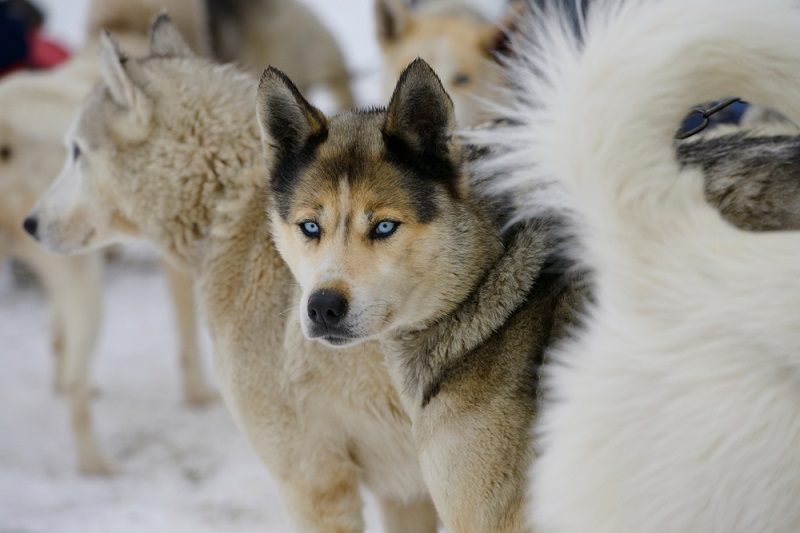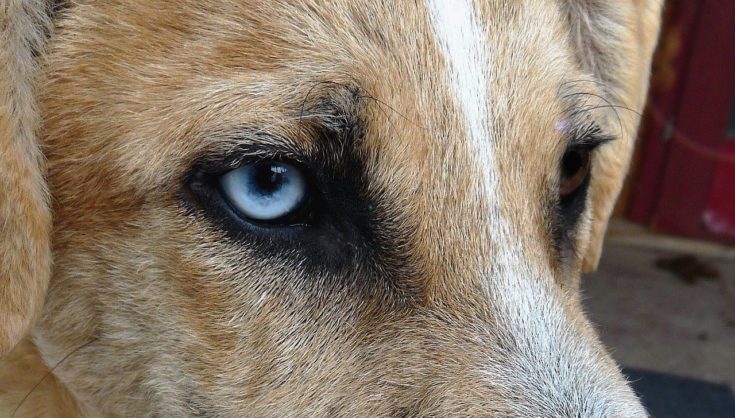7 Types of Dog Eye Colors & Their Rarity (With Pictures)

Updated on

Chances are that you’ve seen a few dogs with some pretty nifty eye colors. Some are vibrant while others blend in neutrally. When you get into specific breed types, you can really start noticing just how prominent some of them are. Genetically, a dog’s eye color is determined before birth, though most are born blue or gray, just like human babies.
But do dogs have the same amount of color choices as us? Let’s find out how many eye colors dogs can have and how hard they are to come by.
What Determines Eye Color in Dogs?
When your dog’s eye color is determined, different factors play a role. If you have a purebred dog, some breeds have specific eye colors based on genetics and coat color. Others can vary depending on the chromosomes that cross.
The most common eye color for dogs is brown, while the rarest is green, but it depends on both parents. Many dogs of the same breed can have different eye colors strictly based on what traits take hold.
The 7 Dog Eye Colors and Their Rarity
1. Brown Eye Color

Brown is the most common eye color in dogs. When there is a major increase in melanin, it produces different shades of neutral browns. Higher levels of melanin make eyes darker.
Because dogs’ genetics carry the high melanin levels so well, many dog breeds display brown eyes, including most mixed breeds. Some purebreds are more prone to brown eyes than others.
- Pomeranians
- Beagles
- German Shepherds
- Labrador Retrievers
- Boxers
- Golden Retrievers
While these dogs have brown eyes most often, it can still show up in virtually any dog breed.
2. Amber Eye Color

Amber is a golden honey color that can show up in many breeds. Amber comes from diluted eumelanin, which is a pigment. It can also come from recessive B or D genes.
Most dogs who have a liver-colored coat have amber eyes. They’re also common among isabella, blue, rust, and gray-coated dogs.
- Clumber Spaniels
- Ibizan Hounds
- Pharaoh Hounds
- Brittany Spaniels
- Chesapeake Bay Retrievers
While amber eyes can show up in lots of coat or breed variations, it can be a disqualifying factor for certain breeds if you plan to show your dog.
3. Blue Eye Color

There are four possible ways for a dog to get blue eyes, three of which are related to coat color. There is a merle gene that comes into play with many blue-eyed breeds.
Merle patterns consist of splatters of different colors and patterns. When you breed merle-patterned dogs, you might run into more health issues than most. This fact is especially true when both parents carry the gene.
Siberian Huskies have another blue gene that is set apart from the rest. Some dogs who have blue eyes might be prone to more health issues, but Huskies are exempt from this category.
- French Bulldogs
- Huskies
- Weimaraners
- Shetland Sheepdogs
- Dalmatians
- Border Collies
- Australian Shepherds
- Corgis
- Dachshunds
Albino dogs have a severe lack of melanin, resulting in an icy blue color, regardless of the breed.
4. Hazel Eye Color

Many dog breeds that can have blue eyes can also have hazel eyes. Hazel is even rarer, but it’s definitely a possibility. Many times, owners will think that their pup’s eyes are staying blue when they start to turn into a complex mixture of beautiful colors.
Hazel eyes have incomplete dominance, which means it can sometimes be a powerful trait, but not always in every genetic combination.
- Pit Bull Terriers
- Labrador Retrievers
- Huskies
- American Staffordshire Terriers
- English Springer Spaniels
- Greyhounds
- Havanese
It might spontaneously show up in some other breeds, though it might be considered a flaw.
5. Green Eye Color

Green eyes are a rare sight to behold in the dog world, being the scarcest color of all. The merle gene that creates blue eyes also influences green pigmentation. There are more health issues seen in dogs who have green eyes.
Many mixed dogs can wind up with this eye color, but it isn’t a breed standard for purebreds. Pit Bulls are the only mentionable dog breed that has green eyes over others.
- Labrador Retrievers
- French Bulldogs
- Alaskan Malamutes
- Beagles
- Mixed Breeds
Maybe it’s the rarity that makes green eyes so beautiful.
6. Complete Heterochromia Eye Colors

While you might not recognize the word, heterochromia is where the dog has two different colored eyes. Heterochromia is seen in several breeds. This condition is caused by a lack of pigmentation in one eye, and it’s usually hereditary.
While most of the time heterochromia is a birth defect, it can also develop later in life due to illness.
- Huskies
- Australian Shepherds
- Great Danes
- Welsh Corgis
- Border Collies
- Shih Tzus
- Chihuahuas
This condition is sure to get compliments, as it creates quite a stunning contrast.
7. Segmental Heterochromia

Rather than having two completely different eye colors, segmental heterochromia happens when each iris has two separate colors. For instance, one part of the iris lacks pigment, while the other has high melanin.
This condition causes the iris to look split, essentially. Any dog that carries the merle gene has the potential to have segmental heterochromia.
Health Issues Associated With Eye Color
There have been rumors over the years that a dog’s eye color can mean they have certain health conditions, and it’s true. Blue dog eyes have been linked to breeds that suffer from blindness or deafness. Merle carriers can suffer while double merle genes are especially susceptible. But it isn’t always a guarantee that it will happen to every dog who carries the gene.
Dalmatians have the highest percentage of deafness in a single breed, making up over 8% bilaterally and 22% unilaterally, which are outstanding numbers.
If you believe your dog’s eye color is changing to blue, this might signal a problem. With cataracts and other eye diseases, the eye may take on a cloudy blue hue.
Get your dog to the vet right away if this has started since going untreated can cause eventual blindness.

Final Thoughts: Eye Color in Dogs
Even though brown is the most common color, all of our dogs’ eyes are unique and special. It’s intriguing how coat color plays such a big factor in eye color. Remember that even if your puppy has stunning blue eyes at 8 weeks, that might change by 3 months.
If you have an adult dog and you think their eyes are changing color, it’s important to get them to the vet, as that could signal other health issues. It’s better to play it safe.
Featured Image Credit: Reimar, Shutterstock











